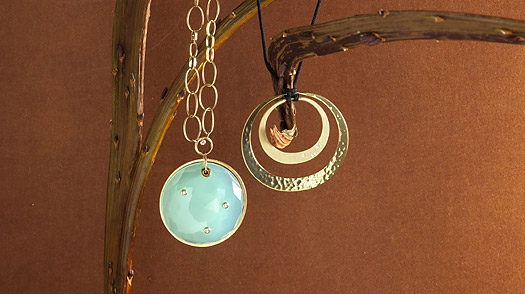
Toby Pomeroy, a jewelry designer based in Corvallis, Ore., knows his market. When the word recycled is used in reference to things like paper and glass, it has a certain sustainable cachet, yet when it's used to describe gold, it loses some of its luster. "I use the term eco-gold or reclaimed gold," Pomeroy says of the metal he sources from refineries, composed of the scraps collected from industry, dentistry and jewelers that's purified back to 24-karat quality. "It elevates it from that blue-bin status on the sidewalk."
Precious metals and gemstones are practically the definition of nonrenewable resources, and more than a few hands get dirty in the nefarious process of unearthing them. When a gem is in a tiny velvet box, spotlit under glass or fastened around your neck, it's easy to forget the origins of fine jewelry. Does anyone want to think about poisoned water or razed mountains, just two of the environmental side effects of gold mining, when she looks at her wedding band? Probably not. And while chic, politically minded eco-warriors may happily trade silk and fur for organic cotton and hemp, sacrificing their bling is often out of the question.
This is the marketing challenge facing the jewelry industry today. As luxury brands redefine themselves in this age of high-end green living, will the makers of fine jewelry be able to adapt? The answer, in many surprising cases, is that they already have. "I operated pretty blithely about that whole matter for a long time," says Pomeroy. "I knew that it wasn't the most pristine practice — getting those metals and gems — and it probably wasn't fair to the people mining them. But I sort of ignored it."
Though Pomeroy considered himself an environmentalist and an activist, as far as his profession as a fine-jewelry designer went, he felt he hadn't much of a choice when it came to his materials. Then in 2004, the nonprofit organization Earthworks (earthworks-action.org), which is dedicated to protecting the environment from the impact of mineral development, sent him information about the No Dirty Gold campaign (nodirtygold.org). Anyone who needs yet another depressing dose of reality should check out either website. Both raise awareness about destructive mining practices — hard-rock-metal mining is the No. 1 toxic polluter in the U.S., contaminating water and air with arsenic and mercury, destroying wildlife habitats and sacred grounds and creating enormous craters visible from space. The No Dirty Gold campaign urges retailers and consumers to sign an agreement stating that they won't purchase jewelry made with irresponsibly mined gold. (Among its supporters are Tiffany & Co., Boucheron and Wal-Mart.) Pomeroy was so moved by the information that he approached a refinery he used as a source for gold in Richmond, Va., and asked it to set aside the scrap and reclaimed gold it received, just for his business. The plan was to use existing gold instead of freshly mined metals. After some convincing, they agreed. "We didn't have any alternative before," explains Pomeroy. "But now the refinery's business has grown exponentially. They're now called Harmony Metals, and they focus completely on reclaimed. They have grown dramatically."
Then in 2007, Pomeroy, along with the likes of De Beers and Earthworks, organized a global mining conference in Washington called the Madison Dialogue. Topics discussed among jewelry makers and miners from places like Peru, Colombia, South Africa and Sierra Leone included the development of a third-party assurance system for products — to be labeled as "ethical" or "fair trade" — and the challenges facing small-scale mining. Earthworks is still in the -process of establishing a certification program called IRMA (the Initiative for Responsible Mining Assurance) to verify sustainable sources -for precious metals.
Seattle-based designer Jamie Joseph was similarly committed to environmental issues, quietly letting her principles guide her long -before eco-awareness made it to the Bergdorf Goodman crowd that's now devoted to her work. And judging by her politics and her environmental commitment, she fits right in with the celebrities who wear Jamie Joseph on the red carpet, including Cameron Diaz and Naomi Watts. She drives a biodiesel car, uses compact fluorescent bulbs and cloth towels in the historic warehouse from which she runs her business and has been using reclaimed gold for close to a decade.
"It's great that the whole green thing is in vogue now, but we've been thinking this way up here for a long time," she says. "My husband, who's also my business partner, has a degree in environmental science. I saw a documentary about mining years ago, and I was really disturbed. But I said, Well, this is my passion — how am I going to address this? I started investigating. And there were vendors that I found where I could buy all-recycled gold."
Joseph also makes an effort to buy "conflict-free" gemstones — those that aren't sold to fund wars or mined by exploited workers in unethical ways — from reliable dealers and often uses less rare, large-scale stones like rose quartz and chalcedony with tiny accents of diamonds. "We work with small owner-operated vendors that have similar beliefs and try to build a community around that," she says. "The whole gemstone industry, it's a little like the used-car business. You've got to know and trust your vendors. We make a point at least once a year of meeting face to face with people. Before I buy a stone from someone, I have to have an interview first. I want to make sure they're not out raping the land."